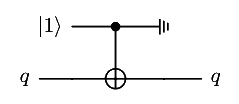QuRA is a static analysis tool for the verification of the resource consumption of circuit-building quantum programs. QuRA takes as input a program written in a variant of Quipper called Proto-Quipper-R and outputs two things: a type for the program and an upper bound to the width of the circuit it builds. A more detailed description of QuRA's input language can be found here. At the heart of QuRA lies a linear dependent type-and-effect system which is described in greater detail in this work.
Consider a function dumbNot defined as:
\q :: Qubit .
let a = apply(QInit1,()) in -- initialize a temporary qubit
let (a,q) = apply(CNot,(a,q)) in -- apply cnot between input and temporary qubit
let _ = apply(QDiscard,a) -- discard temporary qubit
in q -- return input qubit
This function describes a very basic quantum computation in the form of a quantum circuit: the fundamental units of data are Qubits and Bits and computations on these data are carried out by applying elementary operations on them. These operations are either quantum gates (e.g. CNot, Hadamard, etc.) or other operations on bits and qubits (e.g.QInit1, QDiscard, Measure, etc.).
As the name suggests, dumbNot implements the negation of a qubit in a dumb, unnecessarily expensive way. But let's forget about the semantics of this function and let's focus instead on the circuit it builds. Applying dumbNot to an input qubit q produces the following circuit of width 2:
QuRA is able to automatically derive this information from the definition of dumbNot, before it is even run, by inferring for it the following function type:
Qubit -o[2,0] Qubit
The linear arrow is indexed with two numbers: the first one tells us the width of the circuit build by dumbNot once applied to an argument (in this case, 2), while the second one tells us the number of wire references that are captured inside the function's closure (in this case, no wires are captured). The latter index, although exotic in nature, is essential to correctly estimate circuit width in many cases.
Proto-Quipper-R (QuRA's input language) supports a limited form of depdendency, which is precisely restricted to the indices used to annotate types. This allows for the description of circuit families that depend on a natural number parameter. E.g. the qft circuit family is implemented as follows:
... -- definitions for rev, rotate, etc.
@i.\qs :: List[i] Qubit.
let qftStep = lift @j.\(qs, q) :: (List[j] Qubit, Qubit). -- define the step function
let revqs = ((force rev) @j) qs in
let qqs = fold(rotate @j, (q, []), revqs) in
let (q, qs) = qqs in
let q = apply(Hadamard,q) in
q:qs
in fold(qftStep, [], qs) -- fold it over the input list
Abstractions over index variables is achieved through the @ binder. Indices are arithmetic expressions over natural numbers and index variables and are the only kind of term that's allowed to appear in types. Note also that general recursion is not available in Proto-Quipper-R. Instead, a limited form of recursion is made available via the primitive fold construct. QuRA infers the following type for qft:
i ->[0,0] List[i] Qubit -o[i,0] List[i] Qubit
meaning that for every i, qft takes as input i qubits and builds a circuit of width at most i that outputs a list of i qubits.
The whole code for qft, as well as other examples, can be found in the examples directory.
Note: QuRA requires cvc5 to be installed and present in your PATH.
You can then install the tool by running
$ git clone https://github.com/andreacolledan/qura
$ cd qura
$ stack install
To run QuRA on program file FILE, run
$ qura FILE
Use option --debug DEBUG to dump a copy of all SMT queries performed during typechecking to file DEBUG. General usage is thus
qura FILE [-v | --verbose] [-d | --debug DEBUG]
For more information, refer to qura --help.
The implementation of QuRA and its input language are based on "Colledan, A. and Lago, U.D. 2023. Circuit Width Estimation via Effect Typing and Linear Dependency (Long Version). arXiv."
To execute unit tests, run stack test
